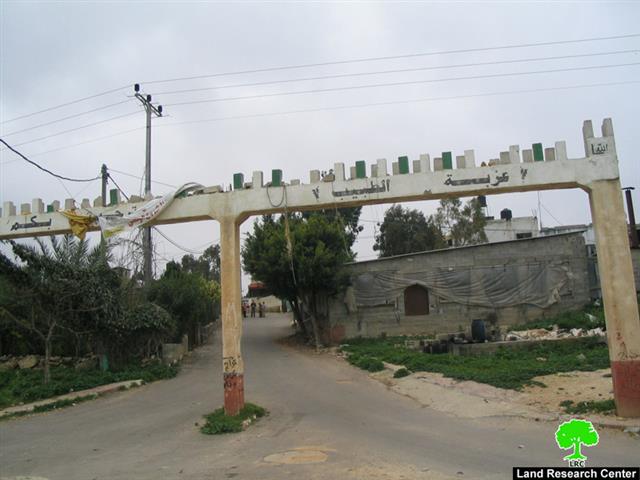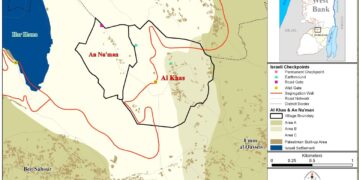On March 3rd, 2007, the Israeli occupation authorities issued a military decree signed by the legal advisor to the Israeli government stating a plan for the construction of a new colonial road through Izbat At Tabib village land in Qalqiliay governorate. The planned road is to connect Alfei Menashei colony with colonies inside Israel. The decree carries the number of 531 and the attached map carries the number of 2/927.
Alfei Menashei colony was established in 1983 and had the population of 5433 settlers in the year 2004 ( source- Foundation for Middle East Peace). Its total municipal area is 4667 dunums and built up area is 1085 dunums ( source- Ibid). The decree claims that the houses of Izbat At Tabib are illegal and that they should all be destroyed and their inhabitants moved to the nearby village of Azzun which is situated 2 km to the south of the Izbat At Tabib.
(Photos 1 & 2: copies of the military order)
The decree goes on to say that the Azzun village could absorb up to 76% of the total population of Izbat At Tabib until the year 2015 and that there is no need to issue a master plan for Izbat At Tabib as all the buildings in it are in violation of Israeli laws and regulations!!
Location, population & area:
The village of Izbat At Tabib is located 7 km to the east of Qalqiliya city with a total surface land area of 635 dunums. It has 226 inhabitants who live in 40 houses which are all roofed with zinc boards as the people are not allowed to use cement material under the pretext that the village is unrecognized by the Occupation Authorities and that the owners have no building permits. See Map 1
(Map 1: location of Izbat At Tabib village)
Originally, the people of Izbat At Tabib derive from the village of Nubsor inside the 1949 Armistice Line (Green Line) who were forcibly made refugees during the war of 1948 and resettled in Izbat At Tabib in the eastern side of 1949 Armistice Line (Green Line). All of the inhabitants are registered refugees with UNRWA.
Threats of obliteration
Since the occupation of the West Bank in 1967 the village has been facing attempts of obliteration at the hands of the Israeli occupation authorities. No village master plan has ever been issued for the village. Therefore, all the houses inside it are considered illegal by the Occupation authorities. In the year 1989, 15 dunums of the village lands were deducted for the construction of the Israel bypass colonial road to the east of the village. Another 93 dunums cultivated with olive and citrus trees were totally damaged under the path of the Segregation Wall and an additional 180 dunums have been separated by the Wall to the west and south of the village.
On the other hand, the Wall has separated behind it the only artisan well that was used to provide the village with water for domestic and agricultural purposes. In the meantime, the Occupation Authorities prevent the inhabitants from constructing or renovating water cisterns, houses, schools, kindergartens and health clinics in the village. No infrastructure whatsoever has been allowed in this village.
Wall data in Izbat At Tabib:
|
Item |
Before the Wall |
Under the path of the Wall |
Separated behind the Wall |
|
Agricultural land |
635 |
93 |
180 |
|
# of Olive trees |
728 |
270 |
190 |
|
# of citrus trees |
295 |
200 |
95 |
|
# of Carob trees |
90 |
50 |
30 |
|
# of Cisterns |
15 |
5 |
1 |
|
# of Artisan well |
1 |
0 |
1 |
|
# of Agricultural roads |
5 |
2 |
0 |
|
# of Plastic houses |
0 |
0 |
0 |
|
# of Animal sheds |
3 |
0 |
0 |
|
# of agricultural nurseries |
1 |
0 |
1 |
Source: Izbat A Tabib Village council
The above data dates back to the year 2005.
Victims' list:
The following is a list of some names of those who received house demolition notifications or notifications for halting construction in the village:
1. Dawood Ibrahim As Sa'di whose house was threatened with demolition in the year 2005. His family is comprised of 13 members;
2. Ahamd Ibrahim Ahmad Ashu'ur whose house was threatened with demolition in the year 2004. His family is comprised of 11 members;
3. Mohammed Sa'id At Tabib, whose barrack was threatened with demolition in the year 2005. The barrack is used for animal rearing;
4. Musa Sa'id At Tabib, a father of 7, whose barrack was threatened with demolition in the year 2005. The barrack is used for animal rearing;
5. Riyad Mohammed At Tabib, who received a notification to halt construction in his house in the year 2006;
6. A notification to halt construction in the public services building was issued at the beginning of this year.
All the aforementioned notifications were issued under the pretext of un-licensing.
Prepared by
The Land Research Center
LRC




















